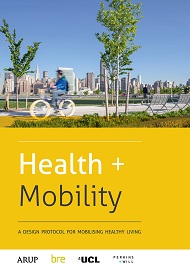Transport design and health
In October 2016, a report published by Arup, BRE, University College London and AREA Research proposed that taking a new approach to designing city streets and other transport infrastructure could have a significant impact on public physical and mental health.
The report’s guidance comes as the NHS is placing increasing emphasis on wellbeing and prevention to help relieve pressure on its services. The number of people suffering chronic diseases, such as stroke, asthma and diabetes, is increasing, posing significant cost burdens on the NHS. The cost of treating diabetes-related conditions alone in the UK was £10 billion in 2011-2012.
The report, 'Health + Mobility: A design protocol for mobilising healthy living', aims to provide civic leaders, city planners and architects with a guidance protocol that can be applied in any urban setting. By taking a more holistic approach to transport design, cities can be helped to identify the health issues that can be influenced.
The research team of public health specialists and built environment professionals found that something as simple as the design of streets, pathways and other networks could have a significant impact on walking, cycling and other physical activities.
The Liverpool Knowledge Quarter in the UK was one of two locations chosen to test the transport design protocol in a real life setting.
The protocol’s application to the Liverpool site highlighted a range of measures that could be implemented to improve underlying health issues in the area. This included reducing the number of wide and busy roads, efficient transport planning and road layout changes and creating more attractive pedestrian and cycling networks.
These changes could facilitate a better street life, improve air quality and encourage people to be more physically active, and they have the potential to help the wider city of Liverpool move towards a healthier environment.
Helen Pineo, associate director for cities at BRE and one of the authors of the guidance, said: “The challenges are so great that they cannot be resolved by health services alone. Planners and designers all have a part to play in promoting health and wellbeing in our cities, and this protocol gives them the tools to create healthier places, without requiring a knowledge of the specialist language of the health sector.”
Professor Nick Tyler from University College London Department of Civil, Environmental and Geomatic Engineering’s Centre for Transport Studies said: “The way we move around the built environment can affect our health in a variety of ways – physically, sensorially and psychologically. By designing the environment to give positive health outcomes we can make a huge difference to people’s quality of life and healthcare needs.
The report, 'Health + Mobility: A design protocol for mobilising healthy living', is available free to download here.
[edit] Related articles on Designing Buildings
- BRE articles on Designing Buildings Wiki.
- Car park.
- Compliant public transport node.
- Cycling and walking plan.
- Data-driven mobility.
- ECA backs joint rail electrification statement.
- Highways in England and Wales.
- Integrated transport system.
- Safe pedestrian route.
- Sustainable transport.
- Road traffic management.
- RORO shipping.
- The history of the dimensions and design of roads, streets and carriageways.
- Traffic and transport.
- Traffic engineering.
- Transport assessment.
- Travel plan.
Featured articles and news
RTPI leader to become new CIOB Chief Executive Officer
Dr Victoria Hills MRTPI, FICE to take over after Caroline Gumble’s departure.
Social and affordable housing, a long term plan for delivery
The “Delivering a Decade of Renewal for Social and Affordable Housing” strategy sets out future path.
A change to adoptive architecture
Effects of global weather warming on architectural detailing, material choice and human interaction.
The proposed publicly owned and backed subsidiary of Homes England, to facilitate new homes.
How big is the problem and what can we do to mitigate the effects?
Overheating guidance and tools for building designers
A number of cool guides to help with the heat.
The UK's Modern Industrial Strategy: A 10 year plan
Previous consultation criticism, current key elements and general support with some persisting reservations.
Building Safety Regulator reforms
New roles, new staff and a new fast track service pave the way for a single construction regulator.
Architectural Technologist CPDs and Communications
CIAT CPD… and how you can do it!
Cooling centres and cool spaces
Managing extreme heat in cities by directing the public to places for heat stress relief and water sources.
Winter gardens: A brief history and warm variations
Extending the season with glass in different forms and terms.
Restoring Great Yarmouth's Winter Gardens
Transforming one of the least sustainable constructions imaginable.
Construction Skills Mission Board launch sector drive
Newly formed government and industry collaboration set strategy for recruiting an additional 100,000 construction workers a year.
New Architects Code comes into effect in September 2025
ARB Architects Code of Conduct and Practice available with ongoing consultation regarding guidance.
Welsh Skills Body (Medr) launches ambitious plan
The new skills body brings together funding and regulation of tertiary education and research for the devolved nation.
Paul Gandy FCIOB announced as next CIOB President
Former Tilbury Douglas CEO takes helm.
UK Infrastructure: A 10 Year Strategy. In brief with reactions
With the National Infrastructure and Service Transformation Authority (NISTA).
























